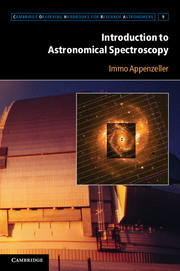Book contents
- Frontmatter
- Contents
- Preface
- 1 Historical Remarks
- 2 Spectroscopy in Present-Day Astronomy
- 3 Basic Physics of Spectral Measurements
- 4 Optical-Range Grating and Prism Spectrometers
- 5 Other Techniques for the Optical Spectral Range
- 6 Preparing and Reducing Optical Observations
- 7 UV, X-Ray, and Gamma Spectroscopy
- 8 Spectroscopy at Radio Wavelengths
- 9 Special Techniques of the FIR and Submillimeter Range
- 10 New Developments and Future Prospects
- Appendix: List of Acronyms
- References
- Index
8 - Spectroscopy at Radio Wavelengths
Published online by Cambridge University Press: 05 January 2013
- Frontmatter
- Contents
- Preface
- 1 Historical Remarks
- 2 Spectroscopy in Present-Day Astronomy
- 3 Basic Physics of Spectral Measurements
- 4 Optical-Range Grating and Prism Spectrometers
- 5 Other Techniques for the Optical Spectral Range
- 6 Preparing and Reducing Optical Observations
- 7 UV, X-Ray, and Gamma Spectroscopy
- 8 Spectroscopy at Radio Wavelengths
- 9 Special Techniques of the FIR and Submillimeter Range
- 10 New Developments and Future Prospects
- Appendix: List of Acronyms
- References
- Index
Summary
Radio astronomers typically use coherent receivers, which record and analyze the electromagnetic radiation directly. As was pointed out in Section 1.4, this facilitates spectroscopy at radio wavelengths. Making use of electronic frequency filters or of natural resonance effects, receivers can be built that are sensitive to a narrow frequency range only. If such receivers contain electronic components for which the parameters can be varied, the receivers can be “tuned” to specific frequencies. In this case, spectra can be be obtained by tuning narrowband receivers within a certain wavelength range, or by combining receivers that are tuned to different frequencies. As described in Section 1.4, the first radio spectra were obtained in this way, and commercially available radio spectrometers still use this technique. However, if spectra are obtained by tuning a receiver, the different frequencies are measured sequentially and the duty cycle for a given frequency is inversely proportional to the spectral resolution. Therefore, such spectrometers are inefficient and not well suited for the low radiation levels of faint astronomical radio sources. To study the very low signal levels from cosmic sources, more efficient methods must be used, which allow us to record many frequencies simultaneously. Some of these methods are described in the following sections.
The aim of this chapter is to provide an introduction to the technical background of the different types of radio spectrometers at a level that an observer needs to select the optimal instrument for a given task and to assess the potentials and the limitations of the different methods.
- Type
- Chapter
- Information
- Introduction to Astronomical Spectroscopy , pp. 200 - 213Publisher: Cambridge University PressPrint publication year: 2012



